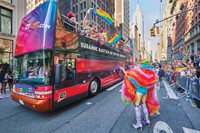As her new book is published, Susanne Bartsch talks about her four-decade reign as New York’s “Queen of Clubs”, and turning nightlife to art
In the summer 1981, Susanne Bartsch arrived in New York by way of London, and quickly set up shop on Thompson Street, bringing British designers like Stephen Jones, John Galliano, Andrew Logan, and BodyMap to Soho at a time when it was a far-flung artist outpost south of 14th Street. Bartsch’s distinctive blend of whimsical glamour and radical chic set the city ablaze, drawing designers like Norma Kamali and Donna Karan to her eponymous boutique and landing a splashy feature in the New York Times.
Buyers at Bloomingdales, Saks Fifth Avenue, and Barney’s New York raced across the pond, feverishly trying to make up for lost time. “I remember thinking, I’m going to get lost,” says Bartsch. Realising the only thing she do was go big, Bartsch decided to stage “New London in New York” fashion show bringing all of the designers together under her wing at the Roxy, a popular Chelsea nightclub and roller rink. “Everyone was on board, all the big models like Iman and Beverly Johnson, they all came and did the show for free to be a part of it. There was a line around the block twice because so many people wanted to go,” says Bartsch. While Leigh Bowery and Rachel Auburn dazzled the crowds, a whirlwind of creative chaos enveloped the scene and inspired a sequel: “London Goes to Tokyo” that autumn.
Amidst the frenetic splendour of adventure, Barstch discovered her purpose was to share this feeling with as many people as she could, and in the spring of 1986 she took her talents to the dancefloor where she embarked on a four-decade reign as New York’s “Queen of Clubs”, elevating nightlife to an art. With the publication of Susanne Bartsch Presents: Bartschland: Tales of New York City Nightlife (Abrams), she takes us on an unforgettable trip through the fashion underground with appearances by an extraordinary cast of characters including Manfred Thierry Mugler, RuPaul, Amanda Lepore, Joey Arias, Kabuki, and Richie Rich.

Hailing from Switzerland, Bartsch is mother to generations of creatures of the night who have fled the strictures of convention in search of freedom and expression. At a time when you had to go places to be seen, Bartsch transformed the club into a living art gallery. She got her start at Savage, a short-lived nightclub that operated out of the basement of the Chelsea Hotel from 1986–1988. “I wanted to do something that was high energy and campy with bright lights for people to show off their looks and be seen,” Bartsch says. “From the moment I opened the door, a thousand people showed up. The first person at the front door was [Village Voice nightlife columnist] Michael Musto in a full look and Roxanne Lowit, the photographer, and I remember thinking, ‘OK, I made it.’”
Success only propelled Bartsch and the community to greater heights. In 1989, she staged the Love Ball to benefit Design Industries Foundation for Aids at a time when the virus was devastating the community. Drawing inspiration from the Harlem ballroom community, Bartsch invited companies like Calvin Klein, Patrick Kelly, Absolut, and Paper magazine to sponsor a house that would battle at Roseland Ballroom that May, raising $2.5 million ($6.3 million in 2024) for the cause. Interview magazine editor Ingrid Sischy declared, “This is probably the greatest political act of our time.” Many who attended the event would soon pass away from Aids, including Keith Haring, Leigh Bowery, and Avis Pendavis, Mother of the House of Pendavis, featured in Paris Is Burning.

Among those in attendance was Madonna, who would release Vogue the following year, bringing ballroom culture to the mainstream. Bartsch entered the decade perfectly aligned with the zeitgeist, never losing step as she continued to craft a path wholly her own. In 1995, she staged Inspiration, a classic runway show, where she decided to walk as the bride and staged the ultimate finale: a surprise wedding to fitness icon David Barton. “We didn’t tell a soul,” says Bartsch, who had 43 bridesmaids including fashion designer Betsey Johnson, Vogue editor Polly Mellen, and B-52s singer Kate Pierson, while RuPaul and Manfred Thierry Mugler stood as groomsmen. “Nobody knew,” she continues. “At the end of the show, I remember Ivana Trump suddenly realised what was happening. She stood up and screamed. This very camp priest came out in a robe, and it was a fantastic wedding.”
Bartsch lives her life as a work of art, allowing the moment to unfold, following her instincts, and remaining open to what is revealed. “I love what I do and I let things in,” she says. “There’s nothing better than being inspired. It’s an amazing feeling; it gives you strength. It’s really a gift.”
Susanne Bartsch Presents: Bartschland: Tales of New York City Nightlife is published by Abrams, and is out now.






